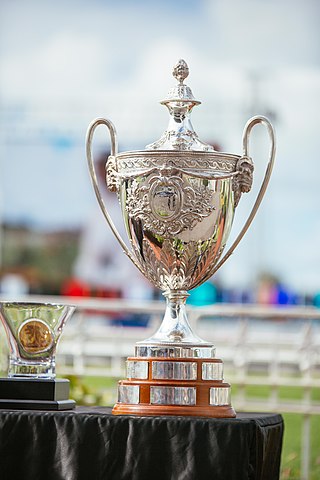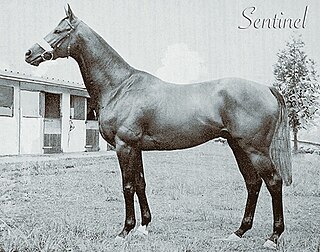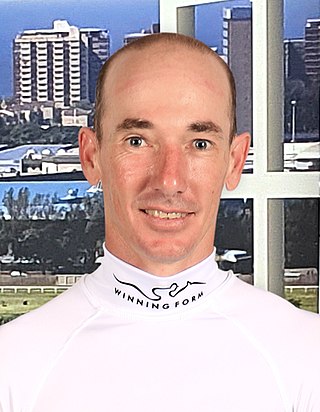
Riccarton Park Racecourse is the main thoroughbred horse racecourse for the Christchurch city area in New Zealand. [1]

Riccarton Park Racecourse is the main thoroughbred horse racecourse for the Christchurch city area in New Zealand. [1]
The Canterbury Jockey Club was established in 1854 and held its first meeting at Hagley Park in Easter 1855. The Riccarton racecourse was reserved as a public recreation ground by the Canterbury Provincial Council in 1858 and leased to the Jockey Club.
Riccarton Racecourse became the home of the New Zealand Cup in 1867.
The Tea House and the Public Grandstand were designed by local architects, Alfred and Sidney Luttrell.
In October 2022, it was reported the Canterbury Jockey Club had been granted permission to demolish the 100-year old grandstand, despite opposition from heritage campaigners. [2]
On the Saturday prior to Canterbury Show and Cup week in November:
On the Wednesday of the Canterbury Show and Cup week:
On the Saturday of the Canterbury Show and Cup week:
In August:
In September:
The Riccarton Racecourse statistical area includes a residential area between the racecourse and the commercial area of Hornby, New Zealand. Including the racecourse, it covers 1.69 km2 (0.65 sq mi). [4] It had an estimated population of 2,110 as of June 2024, [5] with a population density of 1,249 people per km2.
| Year | Pop. | ±% p.a. |
|---|---|---|
| 2006 | 1,170 | — |
| 2013 | 1,215 | +0.54% |
| 2018 | 1,206 | −0.15% |
| Source: [6] | ||
Riccarton Racecourse had a population of 1,206 at the 2018 New Zealand census, a decrease of 9 people (−0.7%) since the 2013 census, and an increase of 36 people (3.1%) since the 2006 census. There were 486 households, comprising 618 males and 588 females, giving a sex ratio of 1.05 males per female. The median age was 38.5 years (compared with 37.4 years nationally), with 174 people (14.4%) aged under 15 years, 273 (22.6%) aged 15 to 29, 552 (45.8%) aged 30 to 64, and 207 (17.2%) aged 65 or older.
Ethnicities were 69.7% European/Pākehā, 8.7% Māori, 5.7% Pasifika, 21.1% Asian, and 3.5% other ethnicities. People may identify with more than one ethnicity.
The percentage of people born overseas was 28.6, compared with 27.1% nationally.
Although some people chose not to answer the census's question about religious affiliation, 45.5% had no religion, 40.5% were Christian, 0.2% had Māori religious beliefs, 2.5% were Hindu, 0.5% were Muslim, 1.5% were Buddhist and 2.7% had other religions.
Of those at least 15 years old, 198 (19.2%) people had a bachelor's or higher degree, and 219 (21.2%) people had no formal qualifications. The median income was $34,800, compared with $31,800 nationally. 120 people (11.6%) earned over $70,000 compared to 17.2% nationally. The employment status of those at least 15 was that 573 (55.5%) people were employed full-time, 126 (12.2%) were part-time, and 39 (3.8%) were unemployed. [6]
Manikato (1975–1984) was a champion Australian Thoroughbred racehorse of the late 1970s and early 1980s. He established new track records in three races and was inducted into the Australian Racing Hall of Fame. Manikato was the second Australian horse, after Kingston Town, to win $1 million in stakes, and, by today's standards, won 20 races which are currently (2012) classed as Group One (G1) races.

The racing of Thoroughbred horses is a popular gaming and spectator sport and industry in New Zealand.

Sha Tin Racecourse is one of the two racecourses for horse racing in Hong Kong. It is located in Sha Tin in the New Territories. It is managed by Hong Kong Jockey Club.

The New Zealand St. Leger is a major thoroughbred horse race run at Trentham Racecourse in New Zealand on New Zealand Oaks day in March each year.
Show Gate is a New Zealand Racing Hall of Fame champion thoroughbred racehorse sired by Gatekeeper out of Minglow, a Eulogy mare.
So Casual is a Thoroughbred racehorse who won the New Zealand Derby in record time in 1998.
The 2000 Guineas is a Group One set-weight Thoroughbred horse race for three-year-old horses run over a distance of 1600 metres at Riccarton Park in Christchurch, New Zealand.

Auckland Cup Week is one of New Zealand's major annual thoroughbred racing carnivals and is the country's richest offering stakes in excess of NZ$2.2 million. Held in Auckland in early March, the carnival comprises two days of racing and entertainment at Ellerslie Racecourse - Vodafone Derby Day and Barfoot & Thompson Auckland Cup Day.

Horse racing is a popular equestrian sport in Japan, with more than 21,000 horse races held each year. There are three types of racing that take place in Japan - flat racing, jump racing, and Ban'ei Racing.
Jezabeel was a top New Zealand thoroughbred racehorse who won the 1998 Melbourne Cup.
Uncle Remus was a champion Thoroughbred racehorse who won the New Zealand Derby and New Zealand 2000 Guineas in the 1977–78 season.
The New Zealand Oaks is a Group 1 Thoroughbred horse race for three-year-old fillies run at set weights over a distance of 2400 metres on the third Saturday of March every year at Trentham Racecourse in Wellington, New Zealand.
The Karaka Million refers to two major New Zealand horse races for young horses - the original Karaka Million for two-year-old (2YO) horses and the Karaka Million 3YO Classic that started in 2018. Held at Ellerslie Racecourse, they are New Zealand's richest races, with a stake of NZ$1,000,000 each. The races are restricted to horses sold through the New Zealand Bloodstock Yearling Sales held at Karaka. The two $1,000,000 races are held on the eve of the National Yearling Sales Series at Karaka.
Trentham Racecourse is the main thoroughbred horse racecourse for the Wellington city area in New Zealand. It is located in the suburb of Trentham in Upper Hutt, next to Trentham Military Camp.

The Awapuni Gold Cup is held annually in Palmerston North, New Zealand. It is a set weight and penalties race over 2,000 metres.

Sentinel was a Champion South African bred Thoroughbred racehorse. He was bred and raced by the Ellis family from Hartford Stud in Kwazulu Natal and trained by Joe Joseph. He raced from 2 to 6 (1971-1975) years of age. He won 29 and placed in 18 of his 56 starts and earned ZAR207,990. He won a record 26 stakes races and was placed in another 17 stakes races. He won from 1000m to 1600m and won the Cape Flying Championship over 1000m in three successive years (1973–75).
Melody Belle is a champion New Zealand Thoroughbred racehorse who is the only horse to win the New Zealand Triple Crown. She is also a two-time New Zealand Horse of the Year and holds the New Zealand record for the most Group 1 races won with 14, surpassing the previous New Zealand record of 13 set by the great mare Sunline and only one off the Australian record of 15 set by Black Caviar.

Warren Brian Kennedy is a South African horse racing jockey currently riding in New Zealand. He was Champion Jockey in South Africa for the 2019/20 and 2021/22 seasons and in New Zealand for the 2023/24 season.
McGinty, known in Australia as Mr McGinty, was a Group 1 winning New Zealand bred and trained race-horse and sire.
Imperatriz is an Australian-bred and New Zealand raced Thoroughbred racehorse, notable for winning nine Group 1 races in New Zealand and Australia. Imperatriz was bred by Raffles Dancers Pty Ltd.